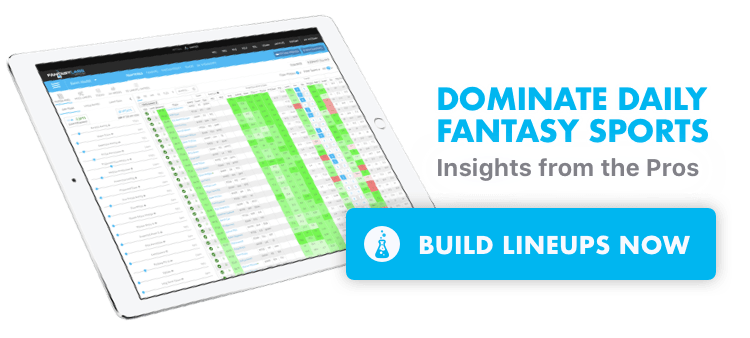It’s Week 2 of the Alliance of American Football, and we thus once again have the luxury of competing in the glorious pasttime known as daily fantasy football.
We have a four-game slate this weekend.
- Saturday 2:00 p.m. ET: Salt Lake Stallions at Birmingham Iron (-7.5)
- Saturday 8:00 p.m. ET: Arizona Hotshots (-12.5) at Memphis Express
- Sunday 4:00 p.m. ET: Orlando Apollos (-6) at San Antonio Commanders
- Sunday 8:00 p.m. ET: Atlanta Legends at San Diego Fleet (-9.5)
FanBall offers daily fantasy contests featuring six-player lineups with a $35,000 salary cap.
- One quarterback
- One running back
- One wide receiver
- Three flex players (running back, wide receiver or tight end)
Scoring is pretty much the industry-wide point-per-reception format with multi-point bonuses for clearing 100, 150 and 200 rushing or receiving yards and 300, 350 and 400 passing yards.
For more in-depth AAF analysis, check out The Action Network. We have you covered with all the AAF content your heart could desire:
- Koerner’s AAF Power Ratings: Spreads That Are Way Off
- AAF Fantasy Football Rankings for Week 2
- Scouting Reports for Every AAF Offense
- Full Week 2 Breakdown on The Action Network NFL Podcast
- Ultimate Week 2 AAF Betting Guide
Before getting into strategy, let’s quickly check in on each team’s quarterback, backfield and receiving room to see who was able to have some success, or at the very least volume, in Week 1.
Salt Lake Stallions
- Starting quarterback Josh Woodrum ($5,500) didn’t finish the second half last week due to a hamstring injury and couldn’t practice Wednesday. Backup Matt Linehan ($5,000) didn’t inspire much confidence in relief, but he costs the stone minimum on a slate where most will likely look to pay up at quarterback.
- The Stallions are rolling with a three-back committee. Joel Bouagnon ($6,600) worked as the lead early-down back with a team-high 16 carries … but he gained a brutal 39 yards (2.4 YPC) and wasn’t targeted. Branden Oliver ($3,900) was the most-efficient back of the group with 40 yards on just eight carries (5 YPC). He worked on all three downs and had three targets. Matt Asiata ($5,200) somehow totaled just four combined yards on four carries and three targets. Asiata was the goal-line back and scored a short touchdown, but Oliver is probably the better dart throw thanks to his cheap price tag.
- Tight end Anthony Denham ($4,800) had seven targets and was the only player with more than five opportunities in the passing game last week. Kenny Bell ($4,800) played a team-high 61 snaps and remains the presumed No. 1 receiver. He’s in a decent bounceback spot after failing to catch any of his three targets last week.
Birmingham Iron
UPDATE (2/15): Trent Richardson was downgraded to a DNP on Thursday due to a hamstring injury. Be sure to monitor his injury situation as kickoff approaches.
- Luis Perez ($6,000) posted top-three marks in yards per attempt (7.6) and completion rate (58%) during the Iron’s dominant 26-0 victory over Memphis despite dealing with a league-high five drops. He’s the cheapest of the AAF’s “big four” quarterbacks priced over $6,000.
Birmingham Iron QB Luis Perez was dropping dimes in Week 1
pic.twitter.com/1hiyat3URF
— Ian Hartitz (@Ihartitz) February 12, 2019
- Trent Richardson ($7,000) racked up a week-high 24 touches and scored twice. Still, he averaged just 2.5 yards per carry and was taken off the field in two-minute situations in favor of backup Ladarius Perkins ($4,800), who wound up catching six of eight targets for 36 yards to complement his five carries for 13 yards on the ground. Perkins’ fantasy-friendly role as a receiver isn’t befitting of the RB11 in FanBall pricing.
- Quinton Patton’s ($6,300) nine targets last week were the second most in the league. No. 2 receiver Amba Etta-Tawo ($6,200) isn’t expected to suit up due to a knee injury, so Patton could again be relied on extensively. No other receivers or tight ends on the Iron managed to surpass even three targets last week, so Patton might be the pricey receiver worth paying up for.
Arizona Hotshots
- John Wolford ($6,600) was brilliant in Week 1 and accordingly has the position’s most-expensive price tag entering Week 2. Wolford’s willingness to take off and run separates him from the league’s other quarterbacks as a fantasy player.
John Wolford is the early frontrunner for AAF QB1
275 yards (No. 1 among QBs)
9.5 Y/A (No. 1)
4 TDs (No. 1)
8 rush attempts (No. 1) pic.twitter.com/mS1WmV021N— Ian Hartitz (@Ihartitz) February 12, 2019
- Jhurell Pressley ($6,900) is my overall No. 1 running back entering Week 2 thanks to his hefty workload on the ground (18 carries) and demonstrated ability to thrive as a receiver out of the backfield (30-yard touchdown reception). Overall, Pressley earned PFF’s third-highest grade in Week 1 for his performance and averaged a robust 3.4 yards per rush after contact. He’s my preferred top-priced play at running back ahead of Richardson.
- Rashad Ross ($6,100) caught five of seven targets for 103 yards and a pair of scores while demonstrating both deep-ball and red-zone chemistry with Wolford. Still, Richard Mullaney ($5,100) and Josh Huff ($5,800) saw six and five targets respectively and now offer steep discounts. Note that Mullaney boasts a second-percentile SPARQ-x score and has the saddest PlayerProfiler athleticism profile that I’ve ever seen.
Memphis Express
- Don’t play Christian Hackenberg ($5,100). Not even if there’s a fire.
- Zac Stacy ($6,300) led the way with 12 carries, but this backfield has the look of a high-variance committee. Each of Terrence Magee ($3,200), Anthony Manzo-Lewis ($3,000) and Rajion Neal ($4,100) saw at least three carries as well. None are particularly enticing options, and Stacy is an easy fade as the slate’s fifth-highest priced back.
- Alton “Pig” Howard ($5,400) and alleged No. 1 receiver Fabian Guerra ($5,400) had six and four targets in Week 1 and seem like the best bets to get going if the Express can eventually figure out their passing game. It’s pretty tough to get excited about anyone in an offense that is yet to score a single point.
Orlando Apollos
- Steve Spurrier and company routed Atlanta and scored a league-high 40 points thanks in large part to Garrett Gilbert’s ($6,300) efficient excellence (9.1 Y/A and 2 TDs with 0 INT). He’s now the second-highest priced quarterback entering a potential shootout indoors in the week’s only matchup with two competent quarterbacks (pending the health of Woodrum).
- The ol’ ball coach looks poised to utilize a three-headed committee. Akeem Hunt ($6,400) started and gained a league-high 73 yards on just 10 carries. Hunt is the best bet for consistent fantasy success since he tentatively appears to be the pass-down back, although he didn’t catch any of his five targets. De’Veon Smith ($3,400) possesses the most size of the group at 5-foot-11 and 223 pounds. He worked as the short-yardage back and scored a one-yard touchdown. D’Ernest Johnson ($4,600) converted five carries into 35 scoreless yards, caught his only target for a 33-yard score while lined up as a receiver and earned PFF’s highest overall grade among all running backs. It’s going to be tough to predict who goes off in any given week in this backfield, but there’s production to be had.
- Orlando might have the best one-two punch at receiver in the league between former NFLers Charles Johnson ($6,000) and Jalin Marshall ($5,200), who posted respective 4-60-0 and 3-51-1 receiving lines last week. Marshall added a touchdown pass and seems positioned for consistent touches as arguably the offense’s most explosive player.

San Antonio Commanders
- Logan Woodside ($6,100) emerged as one of the league’s more-competent signal callers last week. San Antonio scored only 15 points, but Woodside still earned PFF’s second-highest grade among all quarterbacks. Like Gilbert, Woodside could benefit from a potential shootout between two of the league’s better offenses inside the friendly confines of the Alamodome.
- San Antonio utilized a three-headed committee featuring Kenneth Farrow ($6,000), David Cobb ($4,100) and Aaron Green ($4,900). Farrow led the way with 14 carries, while Cobb had nine carries and three targets, and Green had just six carries and one target. Still, Green showed off his 96th-percentile agility score (per PlayerProfiler) on his way to averaging a team-high 7.2 yards per rush, including a ridiculous 5.2 yards per rush after contact.
- The Commanders might have the best group of receivers in the AAF. Mekale McKay ($6,800) racked up a league-high 12 targets in Week 1 and accordingly boasts the slate’s highest salary among all wide receivers. Consider pivoting to Greg Ward ($5,600) and Alonzo Moore ($5,100), who filled out three-wide sets and had a respectable nine and five targets. Ward offers enhanced upside thanks to his extra touches as a passer, rusher and returner, while Moore is the offense’s de facto field-stretcher and averaged the second-most yards per route run (4.88) in the league in Week 1.
Atlanta Legends
- Matt Simms ($5,600) is both awful and on a short leash with Aaron Murray ($5,400) as his backup. This passing game in general should be avoided until further notice. Both their head coach Brad Childress and offensive coordinator Mike Vick have left the team within the last five weeks.
- Tarean Folston ($5,600) pretty much controlled the backfield with team-high marks in snaps (36), carries (12) and targets (4), but Folston totaled just 45 scoreless yards and showed the type of burst we should probably expect from a running back who ran a 4.81-second 40-yard dash in his pre-draft NFL workouts. Still, volume is king, and Folston is pretty much the slate’s cheapest featured back.
RBs with 10+ touches in Week 1 AAF:
Trent Richardson (24 touches – Birmingham)
Jhurell Pressley (19 – ARZ)
Joel Bouagnon (16 – SL)
Tarean Folston (15 – ATL)
Kenneth Farrow (14 – SA)
Zac Stacy (12 – MEM)
Akeem Hunt (10 – ORL)
Ja'Quan Gardner (10 – SD)
David Cobb (10 – SA)— Ian Hartitz (@Ihartitz) February 11, 2019
- Seantavius Jones ($6,500) and Malachi Jones ($5,700) led the way with eight and seven targets. Seantavius finished with a meh 3-43-0 line, while Malachi still has as many catches as you and I do this season. They’re each easy fades at their respective outrageous price tags.
San Diego Fleet
- Mike Bercovici ($5,900) has been benched in favor of Philip Nelson ($5,200). I can’t say many nice things about Mike Martz’s two-back offense that doesn’t prioritize pass protection, but Nelson is cheaper than several backup quarterbacks and offers salary relief.
- Ja’Quan Gardner ($5,400) is in a good bounceback spot after the Fleet passed the ball on a week-high 69% of their plays. He caught two of three targets and gained 17 receiving yards to complement a solid 8-55-0 day on the ground and now gets an Atlanta defense that allowed a robust 5.48 yards per carry to Orlando last week.
- Francis Owusu ($5,900), Brian Brown ($3,000) and tight end Gavin Escobar ($4,700) had seven, seven and six targets, and worked as San Diego’s top options in the pass game. Owusu (6-foot-2 and 221-pounds, 87th-percentile SPARQ-x score) boasts the most physical talent of the group, but Brown’s minimum price tag is tough to ignore.
Roster Construction Notes
- The only quarterback outside of the top-four highest-priced options who is realistically in play is Philip Nelson.
- #TeamJamEmIn is certainly in play with Trent Richardson and Jhurell Pressley at running back. The only other backs who seem to have control of their backfields are Tarean Folston and Ja’Quan Gardner, but their offenses offer much less security.
- The disparity in pricing at wide receiver seems particularly egregious after a one-week sample. Only Mekale McKay had double-digit targets, and he’s easily the most expensive option. Spending down at receiver is preferable than doing so at quarterback or running back.
- Anthony Denham and Gavin Escobar are the highest-priced tight ends and only realistic options to utilize in the flex. I’ll probably avoid the position in general.
Cash Game Strategy
Jamming in running backs Richardson and Pressley gives us $5,275 per player remaining to work with. The easiest way to give yourself plenty of spending room is to take a long look at min-priced wide receiver Brian Brown, who played 48 of 62 snaps (77%) and racked up six targets. Brown even caught both targets from Nelson for 39 yards, indicating that the change at quarterback could even be a positive development. Orlando running back De’Veon Smith ($3,400) is my second-favorite punt option.
I’m inclined to ride with either Woodside or Gilbert at quarterback thanks to the aforementioned potential for a shootout. Going with either signal caller gives you between $11,800 and $12,000 left to spend on two flex positions. Kenneth Farrow, Tarean Folston and Ja’Quan Gardner are your best bets for pure volume, while receivers Greg Ward and Josh Huff might offer a bit more big-play potential.
Tournament Strategy
Nelson and the four high-priced quarterbacks are the only signal callers we can reasonably expect to play the entire game this week. Perhaps Woodside will benefit from reduced ownership because he has the “toughest” matchup according to FanBall’s defensive rankings.
Fading Richardson and/or Pressley might be the move to differentiate lineups. Loading up on volume at running back is the safest thing to do, so pivoting to other lead backs and spending more money at receiver could make sense. Touches are fairly scarce under $5,000 at running back, but each of Aaron Green and D’Ernest Johnson are mid-priced options with big-play ability.
Quinton Patton makes the most sense as the wide receiver to pay up for. Francis Owusu has a low floor and dicey situation under center, but he does offer the ability to differentiate lineups in case Brian Brown winds up being a high-owned dud.
Alonzo Moore is the perfect boom-or-bust tournament option and is in a blowup spot indoors against the Apollos. The likes of Jalin Marshall, Richard Mullaney and Kenny Bell also offer value as mid-priced options at wide receiver. It makes sense to stick with the best offenses when looking at cheap receivers, so consider Orlando backups Chris Thompson and Ishmael Hyman, who cost $3,600 and $3,500 after managing to play 29 and 25 snaps in Week 1.
Core Groups
- San Diego: QB Philip Nelson, WR Francis Owusu, WR Brian Brown
- San Antonio: QB Logan Woodside, WR Greg Ward, WR Alonzo Moore
- Orlando: QB Garrett Gilbert, WR Charles Johnson, WR Jalin Marshall
Dart Throws
- QB: Philip Nelson ($5,200)
- RB: Branden Oliver ($3,900), Justin Stockton ($3,600), Larry Rose ($3,500), De’Veon Smith ($3,400)
- WR: Chris Thompson ($3,600), Ishmael Hyman ($3,500), Brian Brown ($3,000)
Leverage
Arizona running backs Larry Rose ($3,500) and Justin Stockton ($3,600) are both cheap and offer contrarian tournament potential in lineups without Pressley. The same goes for Richardon’s backup Ladarius Perkins ($4,800) to a lesser extent.
Pictured: Trent Richardson
Credit: Birmingham Iron









